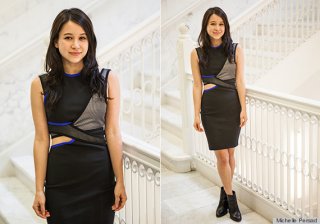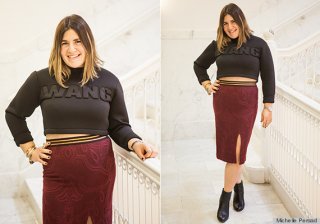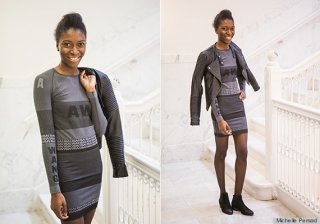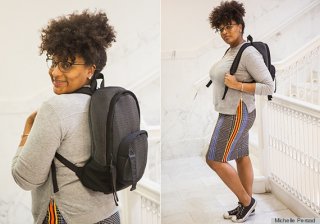TBT: Are Design Houses Doing Enough to Protect Themselves in Light of Collabs?
By TFL | Published October 16, 2014
Alexander Wang announced his upcoming collaboration with H&M this past April. Shortly thereafter, we learned that Kim Jones, Louis Vuitton’s reigning menswear director, would be teaming up with NYC-based DJ/artist collective, BEEN TRILL, for a Harvey Nichols capsule collection, which debuted last month during the London Collections: Men shows. The fact that the two high profile houses, Balenciaga (where Alexander Wang is creative director) and Louis Vuitton, signed off on such projects is interesting. It appears that neither house has a clause in their directors’ contracts prohibiting them from taking on such side projects, and as a result, they are permitted to team up with other brands, whether it be iconic London-based retailer, Harvey Nichols, or Swedish fast fashion giant, H&M. So, I got to thinking, would houses benefit from placing restrictions on their most coveted talent and what do they stand to lose (or gain) by allowing such partnerships?
It is worth noting up front that each specific partnership is quite different, and as a result, each situation varies in terms of pros/cons depending on the design house at issue, the individual designer, the secondary company, their individual target markets, etc. However, in an attempt to make sense of such instances and shed light on this general trend in fashion (which does not appear to be going away any time soon), here’s what we came up with, specifically in regards to Alexander Wang, the latest in a long line of designers to join forces with H&M.
My primary instinct was that Alexander Wang teaming up with H&M was nothing if not dangerous for Balenciaga. (That was almost certainly my old school fashion elitist mentality kicking in, the one that harkens back to the Halston for J.C. Penney disaster and more recently, to the over-saturation of names and logos of high fashion brands in the marketplace, which has been to their detriment). On the heels of the Alexander Wang x H&M announcement, a Google News search of “Balenciaga” confirmed my suspicions; it resulted exclusively in Wang for H&M news for nearly a month, from the date of the collaboration announcement until Alexander Wang began feting the Balenciaga Tokyo flagship in mid-May. The connection seemed dangerously close. Balenciaga for H&M, anyone? And this is exactly what luxury houses are constantly trying to avoid: Likening to both fast fashion brands and “affordable luxury” brands. In this way, the partnership seems as though it could be risky. You cannot charge $3,000 for a bag if consumers don’t view your brand in a certain light (because consumers are not just buying that bag for its superior craftsmanship, they are also buying into the brand’s superior image). Well, actually you can, but they might not sell, as we learned from Louis Vuitton and Gucci and their recent market saturation situations, which subsequently turned consumers off from the brands and sent them into the welcoming arms of logo-free Celine.
Additionally, Balenciaga is a house that is arguably still in transition. Wang, 30, made his Balenciaga debut in February 2013. So, not even two years ago. And while his first handful of collections received largely positive reviews (criticism has been subtle), there has been no shortage of scepticism about his ability to fill former creative director Nicolas Ghesquière’s shoes. “To say that the 41-year-old Ghesquière left big shoes to fill would be a monumental understatement,” Vogue’s Mark Holgate wrote not terribly long ago. Wang has brought his own sensibilities to Balenciaga (“As it goes with experiments, many worked, but some didn’t,” Tim Blanks wrote in his Fall/Winter 2014 review of the house’s womenswear collection)- hence, the transition period.
That’s not all. Rumor has it, the design team currently in place (“the design team [Wang] inherited from his predecessor” as Vogue put it) is slowly but surely withering away since Ghesquière left. Some of the team, “who were close to me,” Ghesquière says, left with him. Marie-Amélie Sauvé, for instance, Ghesquière’s long-time muse and second pair of eyes, who worked each season “from beginning of the creative process with the designer throughout the development of a collection,” left with him. It was reported that some of Ghesquière’s team had decamped to work for Hedi Slimane at Saint Laurent, and still others have found their way to Dior, arguably making this the house’s biggest problem. As a result, an H&M collab hardly seems disastrous.
Still, should Balenciaga be signing off on a mass market collaboration with its relatively new creative director right now? Maybe not. (To alleviate any of Balenciaga’s woes on the matter, Wang’s attention is almost certainly not shifting much due to the collab. In fact, he probably isn’t too involved in the H&M collection at all. The designer is likely licensing his name far more than his expertise to the fast fashion brand, and simultaneously agreeing to do some promotional work for the brand).
This brings me to another point, an important one: Alexander Wang has his own eponymous brand, which is alive and well and is likely at least part of the reason why a restrictive clause preventing partnership projects is not present in his Balenciaga contract. Given the lookbook, which was released today, complete with the Wang-logoed gloves, scuba-style dresses, mesh-panneled garments, and leather, it seems the H&M collection is rather closely tied to Wang’s namesake label than Balenciaga. Moreover, I don’t think it is a stretch for consumers to distinguish between the two brands, Balenciaga, the iconic Paris design house and Alexander Wang, the New York City brand, known for its cool/casual/New York City wares, its slouchy and androgynous aesthetic, and its “model off-duty” style. Thus, Balenciaga probably will not be negatively affected by the collab, even if one cannot help but see the connection, especially since the vast majority of headlines are some variation of: “H&M Teams With Balenciaga’s Wang for Designer Collaboration.” And nothing says “not high fashion” quite like fast fashion.
For Wang’s eponymous label, this very well may be a home run, a way to get his aesthetic out to the masses and maybe even win over some customers to his label and/or his lower-priced T by Alexander Wang collection – both of which price below Balenciaga at retail. Plus, Wang doing fast fashion is not completely out of left field. He is known for doing his own thing, so to speak: featuring less obvious choices in his eponymous and diffusion ad campaigns (think: Die Antwoord and Azealia Banks or posing models on bathroom floors a la his S/S 2014 ad campaign), shying from red carpet fashion because he thinks “it’s so boring, so obvious”), and the list goes on. In this way, the backlash that designers face for teaming up with fast fashion retailers seems way less … important. Wang is American fashion’s golden child, but at the same time, he has been American fashion’s wild child. Of Wang’s appointment at Balenciaga, Virginie Mouzat, an editor at French Vanity Fair, said: “Nicolas Ghesquière made Balenciaga grow up; Balenciaga will make Alexander Wang grow up.” And while his namesake label is certainly maturing, I’m not entirely sure Wang is ready to shed his youthful spirit. Hell, he announced the impending H&M collection at a party at Coachella. In this way, the H&M collab actually seems youthful and fun and even cohesive. (Feel free to argue amongst yourselves about this in the comments section below).
What I still haven’t answered definitively, however, is why? It is rather obvious why emerging brands team up with large retailers for limited-time partnerships; the collections result in marketing that far exceeds the budget of these young brands and help establish their brands (think: big parties, massive ad campaigns, etc.). But why perfectly successful high fashion houses feel the need to create fast fashion and why are they allowed to (given the delicate balance involved with branding and maintaining the branding of a high fashion house) in the first place amount to more difficult questions.
First things first: The danger that could result from high fashion brands being associated with fast fashion brands is maybe lower than ever before. Modern day shopping and consumers’ perceptions of how fashion should be have changed quite a bit over the years. In 1983, when Halston teamed up with JC Penney for a mainstream collection, Bergdorf Goodman immediately refused to continue stocking his designs. It isn’t necessarily like this anymore. Most consumers and retailers have come to see the diffusion line or the mass market collaboration as a way of the fashion world, more or less, and are more forgiving than Bergdorfs was in 1983. This is not to say that if Prada began consistently stocking a collection at Kohl’s, that no one would bat an eye or that there would not be any fall out, but you get my point. With consumers’ increased willingness to construct a wardrobe that consists of both high end items and high street items, the stigma of these types of collaborations has diffused quite a bit. And in case there are individuals still on the fence, fast fashion (and the fast fashion production of luxury houses’ collaboration collections) is so far removed from the world of luxury design (in terms of quality and quantity, at least) that the distinction is obvious and therefore, eliminates quite a bit of the potential danger that may stem from the co-existence of Lanvin and Lanvin for H&M wares, for instance.
Additionally, these collaborations, for the most part, give high fashion houses the opportunity to copy themselves and sell the resulting garments and accessories (and get paid for it), as opposed to merely being copied by fast fashion retailers to their own detriment. (Yes, we know that it doesn’t always stop mass market brands for copying; Target rather notoriously collaborated with Proenza Schouler for a collection and then copied the brand’s famed PS1 bag shortly thereafter). It is not a foolproof method of fighting design piracy, but it isn’t the worst tactic either.
This goes hand in hand with another underlying reason for these collabs, the ability for design houses to reach new audiences. Of the Margiela collection for H&M, which landed in stores in 2012 (and actually didn’t sell very well), actor/frequent fashion event attendee, Alan Cummings, put it quite accurately, saying: “It gives more people more access to things normally available only to the very rich.” Consuelo Castiglioni, the mastermind behind quirky luxury label, Marni teamed up with H&M in 2011, saying: “My main aim, and the biggest inspiration, is the possibility to reach a wider audience with this collection and in particular the younger generations.” Upon the launch of Lanvin’s partnership for H&M in 2010, Hilary Alexander of The Daily Telegraph echoed this sentiment, saying she thought it was “courageous for Alber [Elbaz] and Lanvin to combine with H&M and make this wonderful dream a reality for thousands and thousands of women and girls all around the world.” Worth noting: Not only are the resulting collections cheaper but they are physically more available, as there are far fewer Marni or Margiela stores than there are H&M stores. And in the Karl Lagerfeld x H&M case, the designs were available in a larger range of sizes, from size 0 to 16, quite far beyond the high fashion sizing system. Of the collection, Lagerfeld said: “I like the idea that everyone could wear Lagerfeld.” (You may also recall that the notoriously outspoken/controversial Lagerfeld, spoke out about the sizing, however, saying he had created the collection for “slim, slender people.”).
Lanvin’s creative director Alber Elbaz cited more profound intentions for the collection than simply “doing a dress for less.” He said he wanted to show that “mass production and fast fashion does not have to be generic, you can make it different.” Additionally, he said: “What intrigued me was the idea of H&M going into luxury, rather than Lanvin going public. I wanted to see if we could translate the dream to a wider audience. This has been an exceptional exercise, where two companies at opposite poles can work together because we share the same philosophy of bringing joy and beauty to men and women around the world.” So, it seems that the designers behind the Karl Lagerfeld, Maison Martin Margiela, Isabel Marant, Versace, and other labels that have teamed up with fast fashion retailers (namely, H&M) share the sense of being challenged by the notion and the process of taking their designs and making them accessible to the masses.
With this in mind, I think there is a strong argument that Wang is already quite challenged at the moment, and it may be a misstep on Balenciaga’s part for signing off this project. Moreover, this suggests that maybe high fashion houses could benefit at times from having relatively strict clauses in their design directors’ contracts preventing them from taking on too many projects and spreading themselves too thinly. While such projects may not have negative effects on a brand’s image in terms of negative associations or market saturation, it could certainly have an effect on designers’ focus and the quality of their work. Thoughts?






